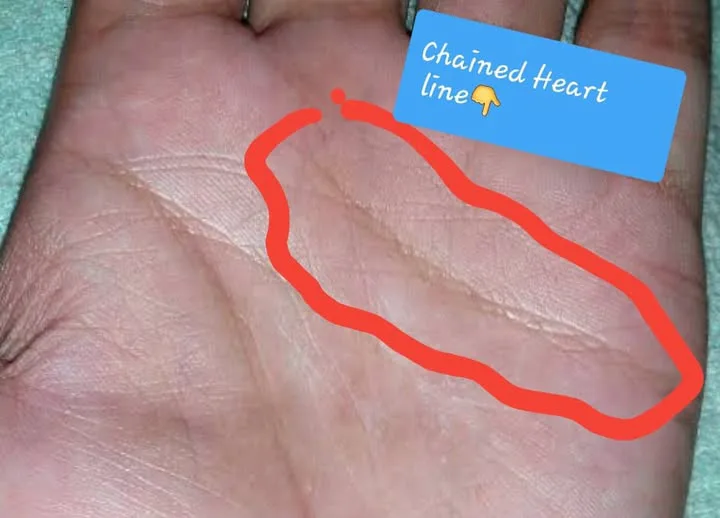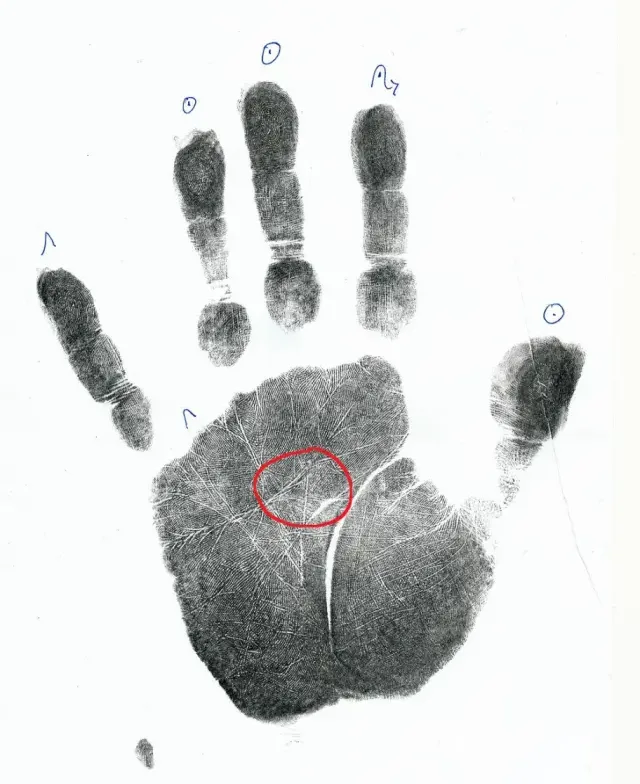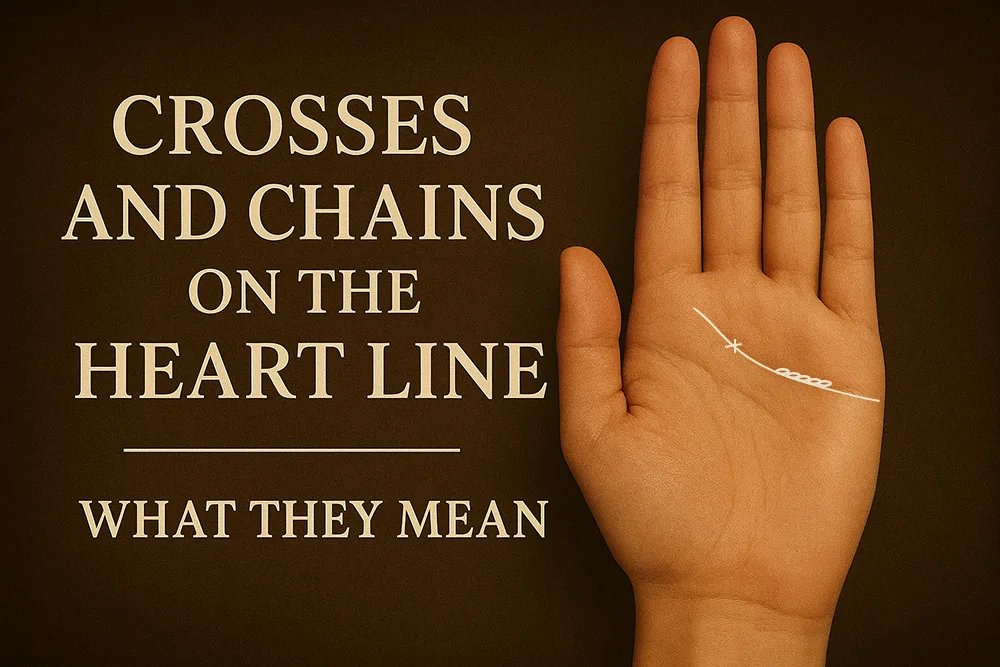Have you ever glanced at your palm and wondered what those intricate lines reveal about your emotional world? In the ancient art of palmistry, also known as chiromancy, the hands are seen as a map of one’s life, personality, and destiny. Among the major lines—the life line, head line, fate line, and heart line—the heart line holds a special place as the window to our affections, relationships, and inner feelings. But what happens when this line isn’t smooth and unbroken? What if it’s marked by chains or interrupted by crosses? These features can add layers of complexity to your reading, offering insights into emotional challenges, resilience, and even potential health concerns related to the heart.
In this comprehensive guide, we’ll dive deep into the meanings of crosses and chains on the heart line. Whether you’re a curious beginner or a seasoned palm reader, understanding these markings can help you interpret your own palm or those of others with greater accuracy and empathy. We’ll explore their appearances, interpretations, positions, and how they interact with other palm features. By the end, you’ll have a solid foundation to apply these concepts in real-life readings.
An Introduction to Palmistry: The Art of Hand Reading
Palmistry has fascinated humanity for millennia, with roots tracing back to ancient civilizations. Historical records suggest that palm reading originated in India around 3000 BCE, where it was intertwined with Vedic astrology. From there, it spread to China, Egypt, and Greece, evolving into various traditions. In ancient Greece, Aristotle is said to have studied chiromancy, believing the hands reflected the soul’s essence. During the Middle Ages in Europe, it was both revered and persecuted, often associated with mysticism and fortune-telling.
Today, palmistry is practiced worldwide, blending traditional interpretations with modern psychological insights. It’s not just about predicting the future; it’s a tool for self-reflection, helping individuals understand their strengths, weaknesses, and life patterns. The palm is divided into mounts (fleshy areas under the fingers), lines, and signs like stars, triangles, and our focus here—crosses and chains.
The dominant hand typically shows current life paths and choices, while the non-dominant hand reveals innate traits and potentials. When examining the heart line, palmists consider both hands for a complete picture. If the heart lines differ between hands, it might indicate personal growth or changes in emotional outlook over time.
Keywords like “palmistry heart line meaning” often lead seekers to this line because it’s directly linked to love and emotions—core aspects of human experience. But before we zoom in on crosses and chains, let’s establish the basics of the heart line itself.
The Heart Line: Location, Types, and General Interpretations
The heart line is one of the four major lines in palmistry, running horizontally across the upper part of the palm, just below the bases of the fingers. It typically starts from the edge of the palm under the pinky finger (Mercury finger) and arcs or runs straight toward the index finger (Jupiter finger) or middle finger (Saturn finger).
To locate it easily: Open your hand palm-up and look for the uppermost major crease. Its starting point, length, depth, and curvature provide clues about your emotional style.
Common Types of Heart Lines
- Curved Heart Line: A gently curving line suggests a warm, expressive personality. You’re likely romantic, empathetic, and open to deep connections. This type is common in creative individuals who wear their hearts on their sleeves.
- Straight Heart Line: If it’s straight and parallel to the head line below it, you might be more logical in matters of love, prioritizing stability over passion. This doesn’t mean you’re unemotional—just that you approach relationships with practicality.
- Long Heart Line: Extending across the entire palm indicates a generous, affectionate nature. You invest deeply in relationships but may risk heartbreak if not balanced.
- Short Heart Line: A shorter line suggests emotional reserve or focus on self. You might be independent, but it could also point to difficulties in expressing feelings.
- Deep vs. Faint Heart Line: A deep line shows strong emotions, while a faint one indicates sensitivity or emotional delicacy.
In Chinese palmistry, the heart line is also called the “love line” and is analyzed for marital prospects and emotional health. For instance, if it ends under the middle finger, it might signify jealousy or possessiveness in love.
The heart line doesn’t just reflect romance; it encompasses all emotional bonds, including family and friendships. It can also hint at cardiovascular health, with breaks or marks sometimes correlating to physical issues—though palmistry isn’t a substitute for medical advice.
Now, imagine this line isn’t pristine. What if it’s fragmented into chains or punctuated by crosses? These variations add nuance, often indicating periods of emotional turbulence or specific events.

Identifying Chains on the Heart Line: What Do They Look Like?
Chains on the heart line appear as a series of small, linked loops or ovals along the line, resembling a chain or braid. Instead of a smooth crease, the line breaks into interconnected segments. This can span the entire line or just a portion, and the density of the chains matters— denser chains suggest more pronounced effects.
To spot them: Examine your palm under good lighting, perhaps with a magnifying glass. Chains are more common than you might think; many people have at least a few links, especially in modern, stress-filled lives.
In palmistry terms, chains differ from islands (isolated ovals) or breaks (complete gaps). Chains imply continuity amid disruption, like emotional experiences that are connected but bumpy.
The Meanings of Chains on the Heart Line: Emotional Insights and Challenges
Chains symbolize a fragmented or fluctuating emotional life. According to traditional interpretations, they indicate sensitivity, mood swings, and a tendency toward emotional entanglements. You’re likely someone who feels deeply but struggles with consistency in relationships.
Positive Aspects
Don’t assume chains are entirely negative. They can represent growth through adversity. As one Reddit discussion notes, chained lines are common and reflect learning via relationship experiences. If the chains resolve into a smoother line later, it suggests overcoming emotional hurdles, leading to greater stability.
For example, someone with chains early in the heart line (near the pinky) might have had a turbulent childhood or early romances but matures into more fulfilling connections.
Negative Aspects
On the flip side, heavy chains can point to prolonged emotional stress, anxiety, or even health issues like nutritional deficiencies affecting the heart. In some readings, they warn of multiple love affairs or indecision in partnerships, leading to heartbreak.
If chains cover the whole line, it might indicate chronic emotional instability, such as mood disorders or difficulty committing. Palmists advise such individuals to seek balance through therapy or mindfulness.
Positional Meanings
- Chains at the Start (Under Pinky): Early emotional confusions, perhaps from family dynamics or first loves.
- Mid-Line Chains: Turmoil in mid-life relationships, like marital issues or career-related stress affecting emotions.
- Chains at the End (Toward Index): Later-life emotional challenges, but often resolvable with wisdom.
In a real-world example, consider a client I once “read” (hypothetically): A woman with mid-line chains had experienced a series of short relationships in her 30s, each teaching her about boundaries. Once aware, she focused on self-growth, and her palm reading encouraged positive change.
Chains can also interact with other lines. If a chain overlaps with the fate line, emotional ups and downs might impact career success.
Identifying Crosses on the Heart Line: Appearance and Variations
Crosses are small X-shaped marks formed by two intersecting lines on or cutting through the heart line. They can be tiny and faint or bold and prominent. Unlike the mystic cross (an X between the head and heart lines indicating intuition), these are specifically on the heart line.
To identify: Look for perpendicular lines crossing the heart line, forming a clear +. Size and clarity matter—a deep cross is more significant than a faint one.
Crosses differ from stars (multiple intersecting lines) or squares (protective signs). They often appear as interruptions, symbolizing pivotal moments.
The Meanings of Crosses on the Heart Line: Obstacles and Transformations
Crosses generally signify emotional obstacles, disappointments, or turning points in love and life. They can indicate heartbreak, loss, or conflicts but also opportunities for growth.
Health-Related Interpretations
In some traditions, a prominent cross on the heart line warns of physical heart issues, like attacks or strokes. Always consult a doctor if concerned, as palmistry is interpretive.
Emotional and Relational Meanings
- Single Cross: A specific emotional event, such as a breakup or betrayal.
- Multiple Crosses: Ongoing challenges, like repeated patterns in relationships.
Positions matter greatly:
- Cross Near the Start: Early-life emotional traumas, perhaps parental issues.
- Mid-Line Cross: Mid-life crises in love, like divorce or unrequited affection.
- Cross at the End: Later challenges, but often leading to resolution.
In Chinese palmistry, a cross might suggest your life is heavily influenced by love, potentially affecting career or studies. It could even hint at a partner’s early passing, though this is rare and contextual.
Positively, crosses can represent resilience. As one source puts it, they offer chances for personal development and determination.
For instance, imagine a man with a cross mid-heart line: He might have faced a major relationship fallout in his 40s, but emerging stronger, finding true love later.

Variations and Combinations: When Chains and Crosses Appear Together
What if your heart line has both chains and crosses? This combination amplifies emotional complexity. Chains provide the backdrop of ongoing fluctuations, while crosses mark specific “crisis points.”
For example:
- A chained line with a cross in the middle might indicate a period of emotional turmoil culminating in a major event, like a painful separation.
- If chains follow a cross, it suggests recovery through smaller ups and downs.
Consider the mounts: A cross on a developed Venus mount (base of thumb) could soften negative meanings, adding passion.
In both hands: Matching markings suggest inherent traits; differences indicate life changes.
Cultural Perspectives on Heart Line Markings
Palmistry varies by culture. In Indian samudrik shastra, chains might link to karma in relationships, while crosses could denote past-life influences.
Chinese interpretations focus on harmony—chains might signal yin-yang imbalances in emotions.
Western palmistry, influenced by figures like Cheiro, emphasizes psychological aspects, viewing chains as sensitivity and crosses as tests of character.
Understanding these perspectives enriches readings, allowing for a multicultural approach.
Common Misconceptions and How to Read Accurately
Myth: Chains or crosses always mean doom. Reality: They’re often growth indicators.
Myth: Palms predict exact events. Reality: They suggest tendencies.
For accurate readings:
- Examine both hands.
- Consider overall palm texture, finger shapes.
- Use intuition alongside knowledge.
- Avoid fear-mongering; focus on empowerment.
Remedies and Advice for Challenging Markings
If chains or crosses suggest issues, palmists recommend:
- Gemstones: Rose quartz for emotional healing.
- Meditation: To stabilize emotions.
- Lifestyle Changes: Heart-healthy diet, exercise.
- Affirmations: For building resilience.
Remember, palms can change over time with personal development.
Frequently Asked Questions (FAQs)
What does a chained heart line mean in palmistry?
A chained heart line often indicates emotional sensitivity, mood swings, and multiple romantic entanglements. It suggests a journey of learning through relationships but can also point to stress or anxiety.
Are crosses on the heart line always bad?
No, while they can signify obstacles or heartbreaks, they also represent opportunities for growth and transformation. Their meaning depends on position and context.
How can I tell if my heart line has chains or just breaks?
Chains look like linked loops, implying connected disruptions, whereas breaks are complete gaps, suggesting more abrupt changes.
Does the heart line change over time?
Yes, lines can evolve with life experiences, reflecting personal growth or shifts in emotional patterns.
What’s the difference between a cross on the heart line and a mystic cross?
A cross on the heart line affects emotions directly, while the mystic cross (between head and heart lines) indicates intuition or psychic abilities.
Can palmistry predict heart health?
It can hint at potential issues, like with prominent crosses, but it’s not diagnostic. See a medical professional for health concerns.
Why do some people have more chains than others?
It often relates to life experiences; stressful environments or sensitive personalities may manifest more chains.
How do I read the heart line in relation to other lines?
Look for intersections—e.g., with the fate line for career-emotion links—or parallels with the head line for balanced mind-heart.
Conclusion: Embracing the Stories in Your Palms
The heart line, with its crosses and chains, tells a tale of emotional depth and human resilience. These markings aren’t flaws but chapters in your life’s story, urging self-awareness and growth. Whether they reveal past pains or future potentials, remember palmistry is a guide, not a gospel. Use these insights to foster better relationships and emotional well-being.
If you’re inspired, examine your own palms or consult a professional palmist. Who knows what secrets your hands hold? Share your experiences in the comments—have you noticed chains or crosses on your heart line?

Related Posts
Multiple Marriage Lines in Palmistry – Interpreting Emotional Bonds
Cross-Cultural Interpretations of the Head Line
Faint Mercury Line – Does It Indicate Weak Health?
Double Fate Line – Dual Careers Explained: Unlocking the Secrets of Your Palm in Palmistry
November 2025 Horoscope: Career Boost for Earth Signs – Taurus, Virgo, Capricorn
Case Studies: Famous Leaders Head Lines